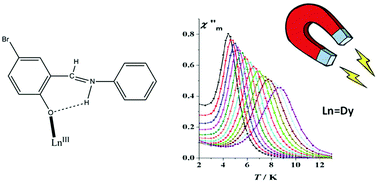Abstract
The initial use of anils, i.e. bidentate Schiff bases derived from the condensation of anilines with salicylaldehyde or its derivatives, in 4f-metal chemistry is described. The 1 : 1 reactions between Ln(NO3)3·xH2O (Ln = lanthanide) or Y(NO3)3·6H2O and N-(5-bromosalicylidene)aniline (5BrsalanH) in MeCN has provided access to complexes [Ln(NO3)3(5BrsalanH)2(H2O)]·MeCN (Ln = Pr, Nd, Sm, Eu, Gd, Tb, Dy, Ho, Er, Yb) and [Y(NO3)3(5BrsalanH)2(H2O)]·MeCN, respectively, in good yields. The structures of the isomorphous complexes with Ln = Pr(1·MeCN), Sm(3·MeCN), Gd(5·MeCN), Dy(7·MeCN) and Er(9·MeCN) have been determined by single-crystal X-ray crystallography. The other complexes were proven to be isostructural with the fully structurally characterized compounds based on elemental analyses, IR spectra, unit cell determinations and powder X-ray patterns. The 9-coordinate LnIII centre in the [Ln(NO3)3(5BrsalanH)2(H2O)] molecules is bound to six oxygen atoms from the three bidentate chelating nitrato groups, two oxygen atoms that belong to the organic ligands and one oxygen atom from the aquo ligand. The 5BrsalanH molecules behave as monodentate O-donors; the acidic H atom is clearly located on the imino N atom and thus the formally neutral ligands adopt an extremely rare coordination mode participating in the zwitterionic form. The coordination polyhedra defined by the nine donor atoms around the LnIII centres are best described as spherical capped square antiprisms. Various intermolecular interactions build the crystal structures and Hirshfeld surface analysis was applied to evaluate the magnitude of interactions between the molecules. Solid-state IR and UV/VIS data are discussed in terms of structural features. 1H NMR data prove that the diamagnetic [Y(NO3)3(5BrsalanH)2(H2O)] complex decomposes in DMSO. Combined dc and ac magnetic susceptibility, as well as magnetization data for 7 suggest that this complex shows field-induced slow magnetic relaxation. Two magnetization relaxation processes are evident. The fit to the Arrhenius law has been performed using the 6.5–8.5 K ac data, affording an effective barrier for the magnetization reversal of 27 cm−1. Cole–Cole plot analysis in the temperature range in which the Orbach relaxation process is assumed, reveals a narrow distribution of relaxation times. The solid Dy(III) complex 7 emits green light at 338 nm, the emission being ligand-centered. The perspectives of the present, first results in the lanthanide(III)-anil chemistry are critically discussed.

- This article is part of the themed collection: Frontiers in coordination chemistry and its applications


 Please wait while we load your content...
Please wait while we load your content...